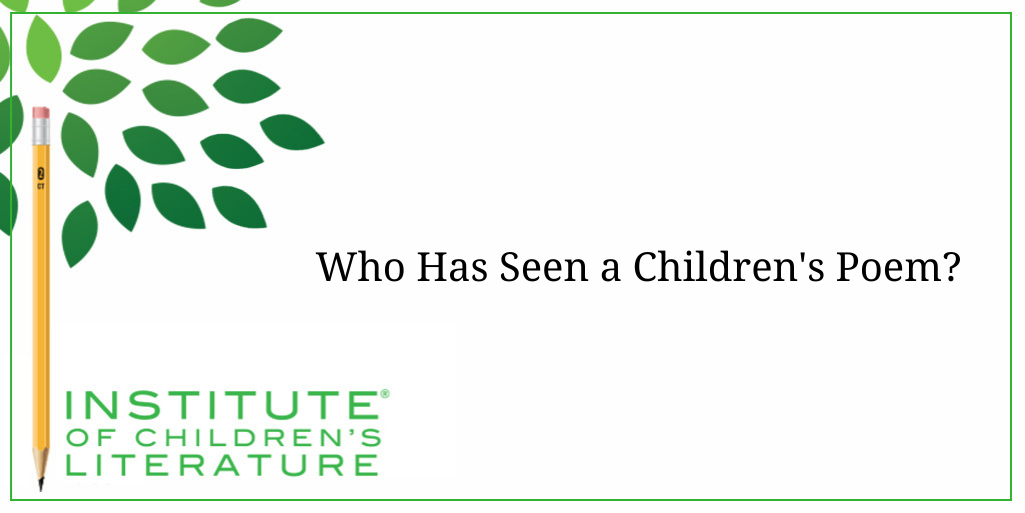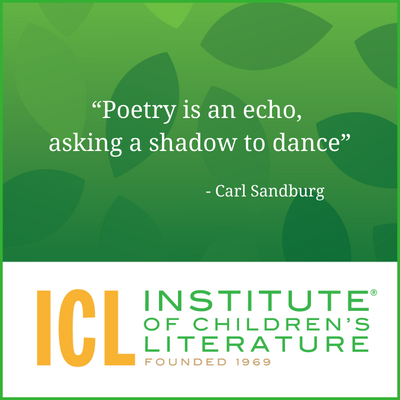
5 Ways Writers Can Prep for 2025 Goal Setting
Before we roll on to the new writing year, let’s harness our optimism for the blank slate before us and prepare for our 2025 Goal Setting just for writers.

We teach our students how to write and get published!
View our Course Catalog >
Who has seen the wind?
Neither I nor you:
But when the leaves hang trembling,
The wind is passing through.
Who has seen the wind?
Neither you nor I:
But when the trees bow down their heads,
The wind is passing by.
This poem, written by Christina Rossetti and published in The Golden Book of Poetry over seventy years ago is, in many ways, the quintessential children’s poem, and studying it can reveal specific things true to nearly all poetry for young children.

One of the reasons the simple and familiar works so well in children’s poetry is because they invite us to slow down and consider a single thing in a new way. Whether it’s wind or clouds or dandelions or making homemade cookies or wondering about daylight savings time, children’s poems invite us to notice and consider things that could be lost in the shuffle of daily life. Also, we must keep in mind that everything in the world is newer for children than it is for us adult writers, so what seems very common to us, still has a certain newness to the young reader, especially if we give them a unique perspective on it.
Rossetti’s poem about the wind invites us to notice the trembling leaves and the way trees bow under the force of wind. She picked specific active imagery that evoked the senses. This is virtually a constant in children’s poetry. It’s part of what invites the child into the poem, because a children’s poem doesn’t simply ask the child to think, it shows them something. Also, sight doesn’t have to be the only sense stirred in a poem. Take for example the first line of Laura Purdie Salas’s poem “Things to Do If You Are a Tree.” In this poem, the writer evokes the reader’s sense of hearing by telling us to imagine being a tree that will “Wake up to geese honks and puddle splashes.” She chose strong sounding verbs “honks” and “splashes” for their sound as much as their meaning. They sound like the thing they identify.
Now, consider this rhyming couplet from “The Treasures” by Clare Bevan: “Who will bring me the scent of the flower?” hummed the Bee. “By the sun’s golden power.” The poet invites us to imagine scent in a new way: the scent of flowers as a treasure that can be carried around by a bee with the assistance of the sun’s golden power. These poems don’t draw on unfamiliar things, but they do look at the very common world in uncommon ways, and they invite the young reader along on the journey through specific sensory details.
Children’s poetry tends to be musical. Poets work with more than the meaning of the words, they work with the sound of the words. Poets use rhyme, repetition, pacing, line length, and the pattern of stressed and unstressed syllables. There is really no detail that is too small to matter in a children’s poem. Consider, for example, how the whole structure of the Rossetti poem depends really on a single thing: the order of the words “you” and “I.” By switching from “Neither I nor you” to “Neither you nor I,” the author gets the sense of repetition (a very musical tool all by itself) with the novelty of a new rhyme option. It’s rather amazing how much she manages to do with that one simple twist. And if you read the two lines aloud, you can hear how much the lines feel different even with the simple change of word order. It’s the perfect example of how much the smallest detail can become important in a children’s poem.
When poets say they build a poem word by word, they are serious. Every word is considered, mulled over, and critically assessed. Nothing gets a pass because any change makes a difference. Some poets even consider the visual of how the words look. There are shaped poems where the poem itself makes a picture because of how it is formatted on a page, but poets also think about how the shape of the words and the length of the lines in the poem in combination with the words themselves affect how the poem is received by the reader.
One thing children’s poems nearly always are is short. Beloved children’s poems are short enough for a child to hold in their heads. I memorized the Rossetti poem that you see at the beginning of this essay when I was very young, and it’s lived in my head ever since. It comes to mind whenever I see the wind tossing branches around or hear it howl. It’s not the only poem I’ve ever memorized, and certainly not the only children’s poem.
In fact, the bite-sized nature of children’s poetry makes them especially easy to tuck away and return to over and over. That is one of the best things about them. A child may ask for the same picture book story read over and over, and even memorize it, but eventually that will fade. You’ll remember bits and bobs, but a poem can slip in and hold itself together over time, always there and always handy. There’s a timelessness in a truly wonderful children’s poem that we never outgrow. And part of that is because children’s poems are about things that will always be part of our lives.
With over 100 books in publication, Jan Fields writes both chapter books for children and mystery novels for adults. She’s also known for a variety of experiences teaching writing, from one session SCBWI events to lengthier Highlights Foundation workshops to these blog posts for the Institute of Children’s Literature. As a former ICL instructor, Jan enjoys equipping writers for success in whatever way she can.

Before we roll on to the new writing year, let’s harness our optimism for the blank slate before us and prepare for our 2025 Goal Setting just for writers.

Writers can be thin-skinned when it comes to getting feedback on their work. Let’s look at 4 ways to positively deal with constructive criticism!

Rejection is part of the territory when it comes to being a writer. Today we offer reflection for writers to help redirect your efforts after a rejection.
1000 N. West Street #1200, Wilmington, DE 19801
© 2024 Direct Learning Systems, Inc. All rights reserved.
1000 N. West Street #1200, Wilmington, DE 19801
© 2024 Direct Learning Systems, Inc. All rights reserved.
1000 N. West Street #1200, Wilmington, DE 19801
© 2024 Direct Learning Systems, Inc. All rights reserved.
1000 N. West Street #1200, Wilmington, DE 19801
© 2025 Direct Learning Systems, Inc. All rights reserved.
1000 N. West Street #1200, Wilmington, DE 19801
©2025 Direct Learning Systems, Inc. All rights reserved. Privacy Policy.
5 Comments
Hello!
Thank you so much for this article about children’s poetry. I am a former teacher and have written and published poems for adults and children, but I needed these reminders to get going again. Also the list of poets and their work, plus a favorite poem, is a wonderful resource!
Vicki Wilke 😊
Loved this post! So true about remembering poems. I read the Book “Just Around the Corner to Spring” as a child. It was my favorite book. I memorized more than one poem form this book. I still remember them all.
Also, so true about action in a children’s poem. In this book, I noticed that the author did just as you pointed out with action.
“Snap Dragon snap, Toadstool turn, Pussy Willow purr, Fireweed burn, Black Eyed Susan wink, Sweet William sing, Forget Me Not remember, it’s Spring Spring Spring”
Thanks for your post!
Diane
Vicki and Diane — thank you so much for your supportive comments and observations.
Jan